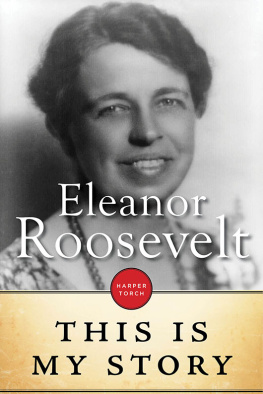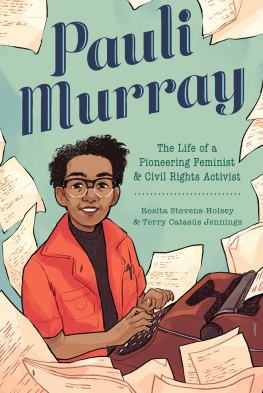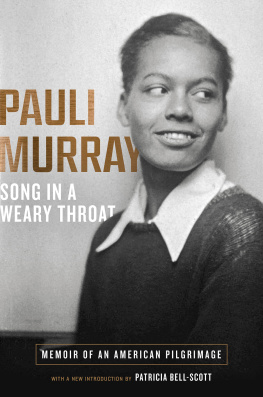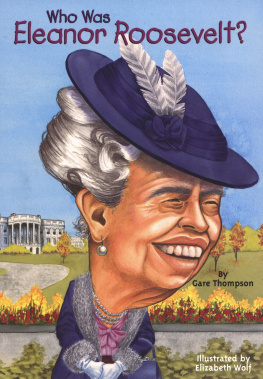THIS IS A BORZOI BOOK PUBLISHED BY ALFRED A. KNOPF
Copyright 2016 by Patricia Bell-Scott
All rights reserved. Published in the United States by Alfred A. Knopf, a division of Penguin Random House LLC, New York, and distributed in Canada by Random House of Canada, a division of Penguin Random House Canada Ltd., Toronto.
www.aaknopf.com
Knopf, Borzoi Books, and the colophon are registered trademarks of Penguin Random House LLC.
Grateful acknowledgment is made to The Estate of Pauli Murray for permission to reprint excerpts of letters, notes, previously published poems, and photographs by Pauli Murray. Other materials are reprinted by courtesy of The Franklin D. Roosevelt Presidential Library, The Literary Estate of Eleanor Roosevelt, and The Walter P. Reuther Library at Wayne State University.
Library of Congress Cataloging-in-Publication Data:
Names: Bell-Scott, Patricia
Title: The firebrand and the first lady : portrait of a friendship : Pauli Murray, Eleanor Roosevelt, and the struggle for social justice / Patricia Bell-Scott.
Other titles: Portrait of a friendship, Pauli Murray, Eleanor Roosevelt, and the struggle for social justice
Description: First edition. | New York : Alfred A. Knopf, [2016]
Identifiers: LCCN 2015033959| ISBN 9781101946923 (eBook) | ISBN 9780679446521 (hardcover : alk. paper)
Subjects: LCSH: Roosevelt, Eleanor, 18841962Friends and associates. | Murray, Pauli, 19101985Friends and associates. | Women social reformersUnited StatesBiography. | Presidents spousesUnited StatesBiography. | African American women civil rights workersBiography. | African American feministsBiography. | Episcopal ChurchClergyBiography. | African American intellectualsBiography. | Female friendshipUnited States.
Classification: LCCE 807.1. R 48 B 45 2016 | DDC 973.917092dc23 LC record available at http://lccn.loc.gov/2015033959
Cover images: (left) Graduation photograph of Anna Pauline (Pauli) Murray, 1933. Courtesy Archives & Special Collections, Hunter College Libraries, Hunter College; (right) Eleanor Roosevelt. Science Source / Getty Images
Cover design by Janet Hansen
eBook ISBN9781101946923
v4.1
a
In memory of Louis Wilbanks Jr., Patrick C. McKenry, and Hilda A. Davisand forCharles Vernon Underwood Jr.
For me, becoming friends with Mrs. Roosevelt was a slow, painful process, marked by sharp exchanges of correspondence, often anger on my side and exasperation on her side, and a gradual development of mutual admiration and respect.
PAULI MURRAY , Challenging Mrs. R., The Hunter Magazine, September 1983
One of my finest young friends is a charming woman lawyerPauli Murray, who has been quite a firebrand at times but of whom I am very fond.
ELEANOR ROOSEVELT , Some of My Best Friends Are Negro, Ebony, February 1953
The measure of her greatness was her capacity for growth, her ruthless honesty with herself, and the generosity with which she responded to criticisms.
PAULI MURRAY , Song in a Weary Throat, 1987
I have known Miss Murray for a long time and she is a very brilliant girl.
ELEANOR ROOSEVELT to David Morse of the International Labour Organization in Geneva, concerning Pauli Murrays application for a staff position, June 14, 1951
She asked me of my future plans and seemed to approve. You would have thought I was talking to either you or Aunt Sallie, the way she talked to me.
PAULI MURRAY to Mother [Pauline Fitzgerald Dame], regarding her first White House visit with Eleanor Roosevelt, June 4, 1943
When more whites and Negroes become friends and lose whatever self-consciousness they started out with, we shall have a much happier world.
ELEANOR ROOSEVELT , Some of My Best Friends Are Negro, Ebony, February 1953
CONTENTS
PART I
TAKING AIM AT THE WHITE HOUSE, 193840
PART II
BUMPING UP AGAINST THE LAW, 194042
PART III
MAKING FRIENDS WITH THE FIRST LADY, 194244
PART IV
STANDING UP TO LIFES CHALLENGES, 194445
PART V
FASHIONING NEW LIVES, 194552
PART VI
DRAWING CLOSER AS FRIENDS, 195255
PART VII
FIGHTING FOR A JUST WORLD, 195659
PART VIII
LIGHTING THE PATH FOR NEW ACTIVISTS, 195962
PART IX
SPEAKING TRUTH TO THE END, 196385
INTRODUCTION: THE HAND OF FRIENDSHIP
You need to know some of the veterans of the battle whose shoulders you now stand on.
PAULI MURRAY TO PATRICIA BELL-SCOTT, DECEMBER 12, 1983
T he letter that carried these words launched a twenty-year odyssey that gave birth to The Firebrand and the First Lady. It was Pauli Murrays second response to my invitation to serve as a consulting editor to SAGE: A Scholarly Journal on Black Women, of which I was cofounding editor. She sprinkled her missive with encouragement and what I self-consciously took as an overstatement, hailing the journal as a formidable undertaking with the potential to transform the mainstream of American scholarship. That this groundbreaking activist, lawyer, writer, and priest had high expectations for my work filled me with excitement and apprehensionlest I fall short.
Prior commitments prevented Murray from contributing to the inaugural issue of SAGE, but she would share reminiscences of people and events that became guideposts along my way. She mentioned the Presidents Commission on the Status of Women, for which she served as a subcommittee member and to which John F. Kennedy appointed Eleanor Roosevelt as commission chair. Murray praised the women activists who had taken the lessons learned in the labor and civil rights movements and applied them to the womens movement. She also boasted that she was finallyfree to do the creative writing she had longed to do since 1939. Her top priority, she quipped, was a dratted autobiography.
Although I dashed off an appreciative reply, I never got the chance to ask Murray about the veterans on whose shoulders I stood. Her death, eighteen months later at age seventy-four from pancreatic cancer, caught me off guard. Having no knowledge of her illness, I had respected her wish to write undisturbed until late in 1984. I kept a list of topics I hoped to discuss when she had a breathing spell. That moment never came.
Pauli Murray had been dead for nine years when I decided to write about her friendship with Eleanor Roosevelt. My interest, piqued by a reference to ER in what proved to be Murrays last letter to me, intensified when I read her autobiography,












